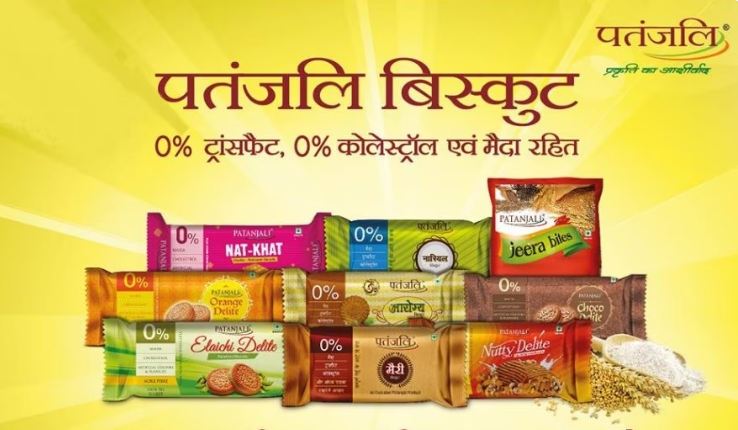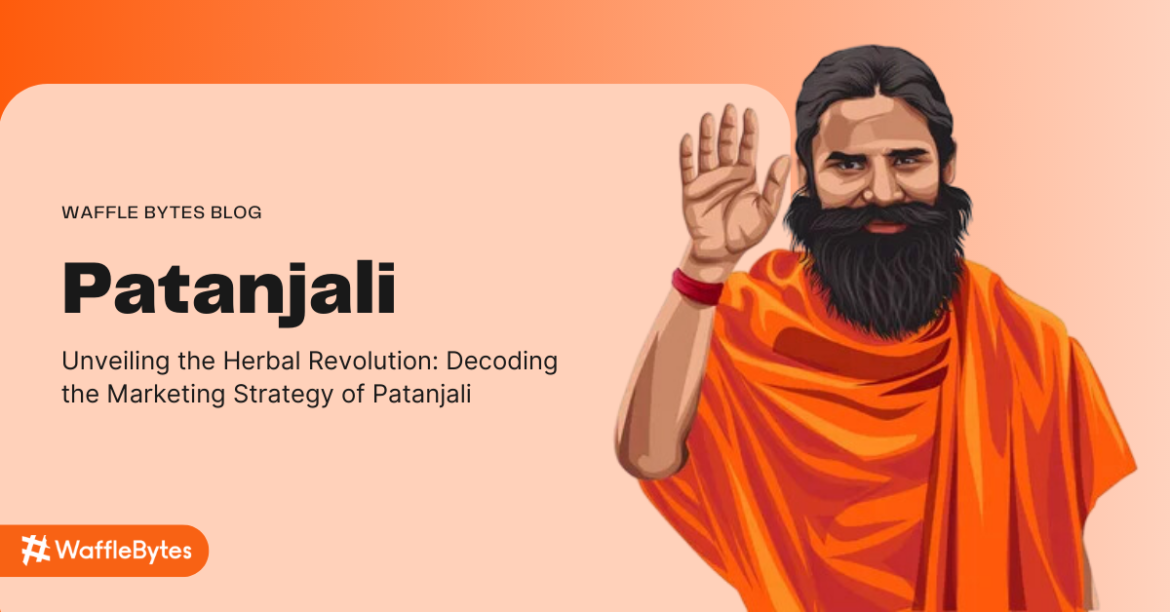Marketing strategy of Patanjali: Patanjali has been the flag bearer of ayurvedic and natural products in India. Patanjali is a renowned Indian consumer goods and Ayurvedic products brand founded by Baba Ramdev, the icon of Yoga and Acharya Balkrishna, in 2006. The first official registered office of Patanjali was in Delhi. Currently, the headquarter of Patanjali is in Haridwar, Uttarakhand, India.
The Patanjali brand aims to promote natural and holistic well-being. Patanjali offers a wide range of products, including food items, personal care products, health supplements, and herbal medicines. The company is committed to providing high-quality, affordable products that harness the power of Ayurveda and traditional Indian wisdom. Patanjali has gained immense popularity in India and established a strong market presence. It has become a trusted brand for health-conscious individuals seeking natural and herbal solutions.
Market Analysis of Patanjali
The current market valuation of Patanjali is around 3000 crore Indian Rupees. Patanjali has consistently made headlines, sometimes for good products and more often for controversial reasons. All of these disputes always work out in the brand’s favour. They increase consumer interest in and enthusiasm for the items. Such products include Coronil, Putrajeevak, and others. Everyone knows about these products because Baba Ramdev created a buzz in the market with all his (Not so true) claims.
Overview of the target market for Patanjali products
The target market of the Patanjali brand can be broadly defined as health-conscious consumers who value natural, organic and Ayurvedic products. Patanjali has positioned itself as a provider of affordable, high-quality products that promote holistic well-being.
It is worth noting that while Patanjali’s target market primarily consists of health-conscious individuals, the brand’s extensive product range allows it to cater to a diverse consumer base with its food, personal care, healthcare, or home care products.
The competitive landscape in the industry
Patanjali operates in a highly competitive industry with domestic and international players. A few big competitors of Patanjali are FMCG giants like Hindustan Unilever & ayurvedic and herbal, organic and natural brands like Dabur and Sri Sri Tattva.
It’s important to note that Patanjali has gained considerable market share and consumer trust despite facing challenges in terms of quality control, distribution network expansion, or competition from established players.
How Patanjali differentiates itself?
- The brand’s success lies in its ability to differentiate itself by focusing on Ayurveda and innovation to meet evolving consumer demands.
- Patanjali’s competitive pricing strategy makes it more attractive to Indian price-sensitive consumers who seek affordable alternatives to established brands in various product categories.
- Patanjali has gained significant popularity among Indian consumers, particularly those who take pride in supporting local brands and indigenous products. The brand has effectively tapped into the patriotic sentiment associated with “Made in India” products.
SWOT analysis of Patanjali
Patanjali, the Indian consumer goods and Ayurvedic products company has significantly impacted the market since its inception. Here’s a market analysis of Patanjali, highlighting its strengths, challenges, and opportunities:
Strengths of Patanjali
- Strong Brand Identity: Patanjali has built a strong brand identity associated with natural and Ayurvedic products, which resonates with health-conscious consumers.
- Extensive Product Range: The company offers a diverse range of products, including food items, personal care products, health supplements, and herbal medicines, catering to various consumer needs.
- Competitive Pricing: Patanjali products are often priced competitively, making them attractive to price-sensitive consumers.
- Distribution Network: Patanjali has established an extensive distribution network, including standalone stores, supermarkets, and e-commerce platforms, ensuring the broad availability of its products.
Weakness and Threats for Patanjali Brand
- Quality Control: Patanjali has faced some challenges related to quality control and product recalls, which have impacted consumer trust and perception.
- Intense Competition: The consumer goods market in India is highly competitive, with both domestic and international players vying for market share, posing challenges to Patanjali’s growth.
- Evolving Consumer Preferences: Consumer preferences are constantly evolving, and Patanjali needs to adapt and innovate to meet changing demands and preferences.
Potential Opportunities for Patanjali
- Growing Demand for Natural and Ayurvedic Products: With increasing awareness about health and wellness, there is a growing demand for natural and Ayurvedic products. This trend presents a significant opportunity for Patanjali to capitalize on its strengths by promoting offerings such as Shilajit Resin and Shilajit Gold, which are known for their health-enhancing properties. These products align with the rising preference for traditional remedies and natural supplements among health-conscious consumers.
- Expanding International Market: Patanjali has been exploring international markets to tap into the global demand for Ayurvedic and natural products.
- Innovation and Product Diversification: By investing in research and development, Patanjali can further innovate its product offerings and diversify into new categories, catering to emerging consumer trends.
Key Elements of Marketing Strategy of Patanjali
The marketing strategy of Patanjali has successfully established the brand presence and helped the brand gain its market share. With an emphasis on an extensive natural ayurvedic product range, and competitive pricing, Patanjali has leveraged the name and face of its co-founder and iconic yoga guru Baba Ramdev as its Brand face. Baba Ramdev is very popular in India, and people live by his words. Patanjali does not have any other celebrity endorsing their products.
Patanjali has adopted a unique approach of minimal advertising expenditure. The company relies heavily on word-of-mouth marketing and the popularity of its founder, Baba Ramdev, to create brand awareness. By minimising marketing costs, Patanjali can allocate more resources to product development and maintain competitive pricing.
Strong Distribution Network
Patanjali has established a robust distribution network across India, including its own retail outlets, known as Patanjali Chikitsalayas, and tie-ups with traditional retail stores. This vast distribution network ensures easy accessibility of Patanjali products to consumers in both urban and rural areas.
Marketing Campaigns by Patanjali
Under the Marketing strategy of Patanjali, the brand has created impactful campaigns that have captured consumers’ attention across various product categories. Known for its focus on natural and Ayurvedic products, Patanjali has aimed to promote its offerings as healthier alternatives to conventional options while emphasising traditional Indian values. Here are a few examples of their notable marketing campaigns:
Jhatpat Banao Befikar Khao: Atta Noodles
Patanjali launched their Atta Noodle campaign when Maggie of Nestle was in controversy. Maggie is a prevalent noodle in India, and these noodles were found with excess content of lead and other chemicals. This news created a vacuum in the market, and people were eagerly waiting for an alternative.
Patanjali launched their Atta Noodles campaign in this need hour and gained popularity. Their Campaign Headline was “Jhatpat Banao Befikar Khao”. Here Jhatpat Banao is to emphasise that it is an alternative for 2 minutes Maggie and Befikar Khao signify that their Atta Noodles are free from the harmful chemicals that other counter products have.
Healthy India banenge, Patanjali biscuit khaenge: Biscuits

Another popular campaign of Patanjali was for its Biscuits. With this, Patanjali targeted the problem of growing obesity and increasing consumption of ‘Maida-based’ food. Patanjali claims their biscuits are free of maida, sugar, and trans fats and are a healthier alternative than any other biscuits available in the Indian Market. The tagline of this campaign says, ‘Healthy India banenge, Patanjali biscuit khaenge’, which means that we shall make India healthy and eat Patanjali’s more nutritious biscuits.
Pricing strategy
Patanjali has implemented a pricing strategy focusing on providing consumers with affordable products. Patanjali offers its products at competitive prices compared to established multinational brands. By keeping costs reasonable, Patanjali targets price-sensitive consumers seeking value-for-money products.
Patanjali follows a strategy of vertical integration, where it controls various stages of the supply chain, including sourcing, manufacturing, and distribution. By eliminating intermediaries and reducing associated costs, Patanjali is able to offer products at lower prices to consumers.
Promotional activities
Patanjali has utilised various promotional activities to create brand awareness and engage with its target audience. Through these promotional activities, Patanjali has successfully gained consumer trust and established itself as a prominent player in the Indian consumer goods market. Some key promotional activities undertaken by Patanjali include:
1. Television Advertisements
Patanjali has invested in television advertising to reach a broad audience across India. The company has aired commercials highlighting its products’ natural and Ayurvedic attributes, featuring founder Baba Ramdev.
2. Print Advertisements
Patanjali has leveraged print media to promote its products. The company has released advertisements in newspapers and magazines, showcasing its offerings and emphasising its health benefits and natural ingredients.
3. Digital Marketing Strategy of Patanjali
Patanjali maintains an active online presence through its official website and social media platforms, including Facebook, Twitter, and Instagram. Patanjali shares product information and health tips and engages with followers through these channels. It also operates an e-commerce platform to facilitate online sales and reach tech-savvy consumers.
4. Product Packaging and Branding
Patanjali pays attention to its product packaging, using distinctive labels and design elements. The packaging prominently displays the company logo and highlights key product features, such as natural ingredients and health benefits. This branding strategy helps attract consumer attention and differentiate Patanjali products on the shelves.
5. Events and Sponsorships
Patanjali has participated in various events and sponsorships to increase its brand visibility. Patanjali sponsored “India’s Best Dramebaaz” a reality show on Zee TV. The company has been associated with yoga camps, health and wellness expos, and other related events. These engagements allow Patanjali to connect with its target audience, educate them about its products, and build brand loyalty.
6. Direct Marketing and Sales Promotions
The marketing strategy of Patanjali encompasses direct marketing techniques, such as door-to-door campaigns, to interact directly with consumers and promote its products. The company also offers discounts, combo packs, and special promotions to incentivise purchases and encourage brand loyalty.
7. Word-of-Mouth Marketing
Patanjali has benefited from strong word-of-mouth marketing. Satisfied customers share their positive experiences with Patanjali products, leading to increased brand awareness and attracting new customers through recommendations.
8. CSR Initiatives
Patanjali actively engages in Corporate Social Responsibility (CSR) initiatives, contributing to its promotional efforts. The company’s involvement in social causes, such as organic farming, rural development, and education, creates a positive brand image and resonates with socially conscious consumers.
Conclusion
Patanjali has successfully positioned itself as a leading brand in the Indian consumer goods market. Patanjali has a focus on natural and Ayurvedic products. The company has leveraged its strong brand identity, competitive pricing, and extensive distribution network to reach various consumers. Patanjali’s marketing campaigns have effectively communicated the benefits of its products. At the same time, its promotional activities have helped build brand awareness and trust. By continuously adapting to evolving consumer preferences and investing in innovation, Patanjali has carved a niche for itself in the industry and is poised for further growth and success.

